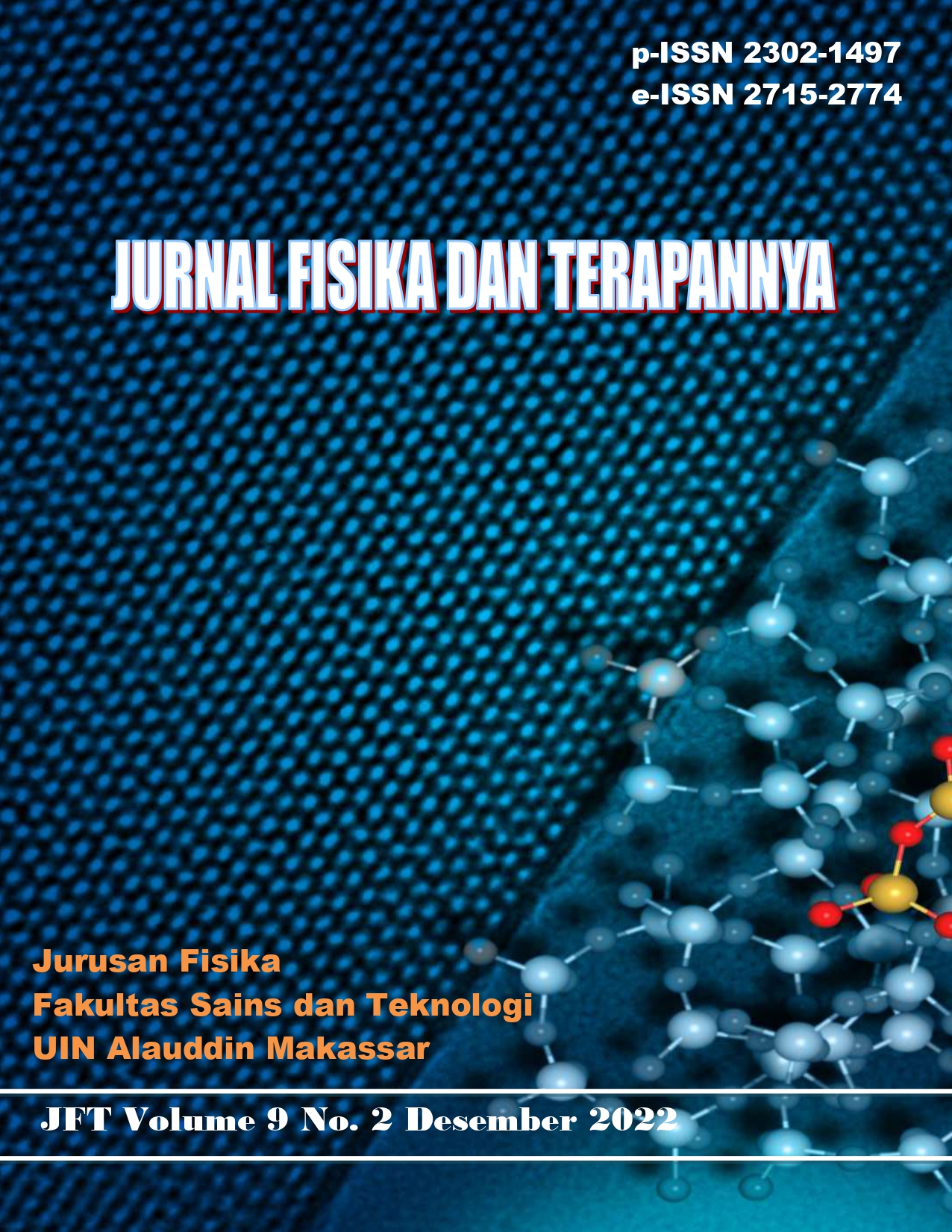Analisis Pengaruh Variasi Suhu Pembakaran Terhadap Mikrostruktur Dan Kandungan Silika Abu Kulit Kakao (Theobroma Cacao) Dengan Metode SEM Dan XRD
Abstract
This study aims to determine the effect of combustion temperature on the microstructure and particle diameter of the average silica ash of cocoa shells, and to determine the effect of combustion temperature on the silica content of cocoa shell ash. The method used is experimental through a quantitative approach. The basic material used is cocoa husk (Theobroma cacao) with combustion temperatures of 450, 550, 650, and 750 oC. The tests used to determine the microstructure and silica content of cocoa husk ash were SEM and XRD after which they were analyzed again using Digimizer Software and X-Powder Software. SEM results based on microstructure indicate the occurrence of agglomeration in the cocoa ash silica sample, and it is known that the particle diameter size of sample A = 1,6916 µm, sample B = 0,7824 µm, sample C = 0,7809 µm, and sample D = 0,7173 µm. Based on the XRD results, it can be seen that the silica contained in sample A = 34,8%, sample B = 49,0%, sample C = 65,0%, and sample D = 70,6%. Based on the SEM results, the best results are in the sample which has the smallest size, namely sample D with a particle diameter of 0,7173 µm and based on XRD results the best results are in sample D with the highest SiO2 content of 70,6%. So that the combustion temperature affects the results of SEM and XRD where the effective temperature in the manufacture of cocoa shell ash silica is 750 oC.
Downloads
References
A. Chandra, Y. A. Miryanti, L. B. Widjaja, and A. Pramudita, “Isolasi dan Karakterisasi Silika dari Sekam Padi,” Res. Rep. - Eng. Sci., vol. 2, 2012, Accessed: Dec. 20, 2022. [Online]. Available: https://journal.unpar.ac.id/index.php/rekayasa/article/view/170
Aman and P. S. Utama, “Pengaruh Suhu dan Waktu Pada Ekstraksi Silika dari Abu Terbang (Fly Ash) Batubara,” Jun. 2014, Accessed: Dec. 20, 2022. [Online]. Available: https://repository.unri.ac.id/xmlui/handle/123456789/6457
D. M. Anggia and S. Suprapto, “Pemurnian Silika Pada Abu Layang Dari Pembangkit Listrik di Paiton (PT YTL) Dengan Pelarutan Asam Klorida dan Aqua regia,” J. Sains Dan Seni ITS, vol. 5, no. 2, Art. no. 2, Nov. 2016, doi: 10.12962/j23373520.v5i2.17415.
E. Erawati and A. Fernando, “Pengaruh Jenis Aktivator dan Ukuran Karbon Aktif terhadap Pembuatan Adsorbent dari Serbik Gergaji Kayu Sengon (Paraserianthes Falcataria),” J. INTEGRASI PROSES, vol. 7, no. 2, Art. no. 2, Dec. 2018, doi: 10.36055/jip.v7i2.3808.
F. Farikhin, M. T. Ir. Ngafwan, and S. T. Joko Sedyono, “Analisa Scanning Electron Microscope Komposit Polyester Dengan Filler Karbon Aktif dan Karbon non Aktif,” s1, Universitas Muhammadiyah Surakarta, 2016. doi: 10/BAB%20V.pdf.
H. Kiswanto, “Analisis Perubahan Struktur Kristal dan Distribusi Kation Cobalt Ferrite Akibat Subtitusi Zinc,” JIIF J. Ilmu Dan Inov. Fis., vol. 4, no. 2, Art. no. 2, Aug. 2020, doi: 10.24198/jiif.v4i2.28357.
I. Irmawati, “Pemanfaatan Silika (SiO2) Alam Gunung Latimojong Teraktivasi Asam Klorida (HCl) sebagai Adsorben Logam Timbal (Pb),” diploma, Universitas Islam Negeri Alauddin Makassar, 2018. Accessed: Dec. 20, 2022. [Online]. Available: http://repositori.uin-alauddin.ac.id/16327/
I. Ishar, “Ekstraksi dan Karakterisasi Silika dari Abu Ampas Tebu (Saccharum officinarum L.) sebagai Material Anti Korosi Pada Baja Karbon,” other, Universitas Hasanuddin, 2021. Accessed: Dec. 20, 2022. [Online]. Available: http://repository.unhas.ac.id/id/eprint/8630/
J. Pusvitasari, P. Manurung, and P. K. Karo, “Pengaruh Variasi HCl Pada Pemurnian Silika Berbasis Batu Apung,” J. Teori Dan Apl. Fis., vol. 6, no. 1, Art. no. 1, Jan. 2018, doi: 10.23960/jtaf.v6i1.1833.
L. Hakim, M. Dirgantara, and M. Nawir, “Karakterisasi Struktur Material Pasir Bongkahan Galian Golongan C Dengan Menggunakan X-Ray Difraction (X-RD) Di Kota Palangkaraya,” J. Jejaring Mat. Dan Sains, vol. 1, no. 1, Art. no. 1, Sep. 2019, doi: 10.36873/jjms.v1i1.136.
L. V. Sari, P. Manurung, and Y. Yulianti, “Pengaruh Variasi Konsentrasi HCl Pada Pembentukan Nanosilika Berbasis Batu Apung,” J. Teori Dan Apl. Fis., vol. 7, no. 2, Art. no. 2, Jul. 2019, doi: 10.23960/jtaf.v7i2.1945.
M. Munasir, T. Triwikantoro, M. Zainuri, and D. Darminto, “Uji XRD dan XRF pada Bahan Meneral (Batuan DAN Pasir) sebagai Sumber Material Cerdas (CaCO3 DAN SiO2),” J. Penelit. Fis. Dan Apl. JPFA, vol. 2, no. 1, Art. no. 1, Jun. 2012, doi: 10.26740/jpfa.v2n1.p20-29.
T. N. Malika, “Analisis Kualitas Lis Profil Gipsum Dengan Variasi Penambahan Batang Kelor (Moringa oleivera),” skripsi, Universitas Islam Negeri Sumatera Utara, 2021. Accessed: Dec. 20, 2022. [Online]. Available: http://repository.uinsu.ac.id/12539/
T. Trianasari, P. Manurung, and P. K. Karo, “Analisis dan Karakterisasi Kandungan Silika (SiO 2 ) sebagai Hasil Ekstraksi Batu Apung ( Pumice ),” J. Teori Dan Apl. Fis., vol. 5, no. 2, Art. no. 2, Jul. 2017, doi: 10.23960/jtaf.v5i2.1814.
T. Y. Rozi and A. Astuti, “Pengaruh Temperatur Kalsinasi pada Sintesis Nanopartikel Silika Pantai Purus Kota Padang,” J. Fis. Unand, vol. 5, no. 4, Art. no. 4, Oct. 2016, doi: 10.25077/jfu.5.4.351-356.2016.
Copyright (c) 2022 Abdul Halim Daulay, Masthura, Arninda Pratiwi

This work is licensed under a Creative Commons Attribution 4.0 International License.


